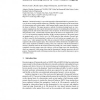Free Online Productivity Tools
i2Speak
i2Symbol
i2OCR
iTex2Img
iWeb2Print
iWeb2Shot
i2Type
iPdf2Split
iPdf2Merge
i2Bopomofo
i2Arabic
i2Style
i2Image
i2PDF
iLatex2Rtf
Sci2ools
ISER
2004
Springer
2004
Springer
Imitation Learning Based on Visuo-Somatic Mapping
Abstract. Imitation learning is a powerful approach to humanoid behavior generation, however, the most existing methods assume the availability of the information on the internal state of a demonstrator such as joint angles, while humans usually cannot directly access to imitate the observed behavior. This paper presents a method of imitation learning based on visuosomatic mapping from observing the demonstrator’s posture to reminding the self posture via mapping from the self motion observation to the self posture for both motion understanding and generation. First, various kinds of posture data of the observer are mapped onto posture space by self organizing mapping (hereafter, SOM), and the trajectories in the posture space are mapped onto a motion segment space by SOM again for data reduction. Second, optical flows caused by the demonstrator’s motions or the self motions are mapped onto a flow segment space where parameterized flow data are connected with the corresponding m...
ISER 2004 | Posture Space | Robotics | Self Motion | Self Posture |
| Added | 02 Jul 2010 |
| Updated | 02 Jul 2010 |
| Type | Conference |
| Year | 2004 |
| Where | ISER |
| Authors | Minoru Asada, Masaki Ogino, Shigeo Matsuyama, Jun'ichiro Ooga |
Comments (0)

